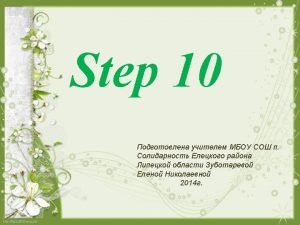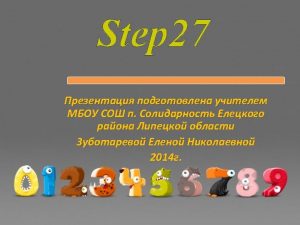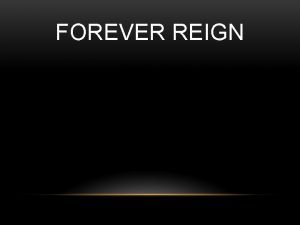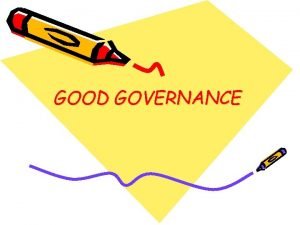i t s good and good for you











































- Slides: 43

i t ’s good and good for you Chapter Six Business Markets and Business Buying Behavior Copyright © 2012 Pearson Education, Inc. Publishing as Prentice Hall 6 -

Business Markets and Business Buying Behavior Topic Outline • • • Business Markets Business Buyer Behavior The Business Buying Process E Procurement: Buying on the Internet Institutional and Government Markets Copyright © 2012 Pearson Education, Inc. Publishing as Prentice Hall 6 - 2

Business Markets Business buyer behavior refers to the buying behavior of the organizations that buy goods and services for use in production of other products and services that are sold, rented, or supplied to others. Business buying process is the process where business buyers determine which products and services are needed to purchase, and then find, evaluate, and choose among alternative brands Copyright © 2012 Pearson Education, Inc. Publishing as Prentice Hall 6 - 3

Business Markets • The business market is huge. In fact, business markets involve far more dollars and items than do consumer markets. • The main differences between consumer and business markets are in market structure and demand, the nature of the buying unit, and the types of decisions and the decision process involved. (See Table 6. 1) Copyright © 2012 Pearson Education, Inc. Publishing as Prentice Hall 6 - 4

Business Market Structure and Demand Fewer and larger buyers Derived demand • Inelastic demand • Fluctuating demand Buyer and seller dependency Copyright © 2012 Pearson Education, Inc. Publishing as Prentice Hall 6 - 5

Market Structure and Demand • The business marketer normally deals with far fewer but far larger buyers than the consumer marketer does. • Even in large business markets, a few buyers often account for most of the purchasing. • Business demand is derived demand. It ultimately derives from the demand for consumer goods. B to B marketers sometimes promote their products directly to final consumers to increase business demand. Copyright © 2012 Pearson Education, Inc. Publishing as Prentice Hall 6 - 6

• Many business markets have inelastic demand; that is, total demand for many business products is not affected much by price changes, especially in the short run. • Business markets have more fluctuating demand. The demand for many business goods and services tends to change more—and more quickly—than the demand for consumer goods and services does. Copyright © 2012 Pearson Education, Inc. Publishing as Prentice Hall 6 - 7

Business Markets Decision Process • More complex • More decision participants • More professional purchasing effort Copyright © 2012 Pearson Education, Inc. Publishing as Prentice Hall 6 - 8

Nature of the Buying Unit • Compared with consumer purchases, a business purchase usually involves more decision participants and a more professional purchasing effort. • Often, business buying is done by trained purchasing agents who spend their working lives learning how to buy better. • The more complex the purchase, the more likely that several people will participate in the decision making process. Copyright © 2012 Pearson Education, Inc. Publishing as Prentice Hall 6 - 9

• Types of Decisions and the Decision Process • Business buyers usually face more complex buying decisions than do consumer buyers. Purchases often involve large sums of money, complex technical and economic considerations, and interactions among many people at many levels of the buyer’s organization. • The business buying process also tends to be more formalized than the consumer buying process. • In the business buying process, buyer and seller are often much more dependent on each other. Copyright © 2012 Pearson Education, Inc. Publishing as Prentice Hall 6 - 10

Business Buyer Behavior Major Types of Buying Situations Straight rebuy is a routine purchase decision such as reorder without any modification Modified rebuy is a purchase decision that requires some research where the buyer wants to modify the product specification, price, terms, or suppliers New task is a purchase decision that requires thorough research such as a new product Copyright © 2012 Pearson Education, Inc. Publishing as Prentice Hall 6 - 11

Major Types of Buying Situations • There are three major types of buying situations: • In a straight rebuy, the buyer reorders something without any modifications. It is usually handled on a routine basis by the purchasing department. • In a modified rebuy, the buyer wants to modify the product specifications, prices, terms, or suppliers. The modified rebuy usually involves more decision participants than does the straight rebuy. • A company buying a product or service for the first time faces a new task situation. In such cases, the greater the cost or risk, the larger the number of decision participants and the greater their efforts to collect information will be. Copyright © 2012 Pearson Education, Inc. Publishing as Prentice Hall 6 - 12

Business Buyer Behavior Major Types of Buying Situations Systems selling involves the purchase of a packaged solution from a single seller Copyright © 2012 Pearson Education, Inc. Publishing as Prentice Hall 6 - 13

• Many business buyers prefer to buy a complete solution to a problem from a single seller. Instead of buying and putting all the components together, the buyer may ask sellers to supply the components and assemble the package or system. Thus, systems selling is often a key business marketing strategy for winning and holding accounts. Copyright © 2012 Pearson Education, Inc. Publishing as Prentice Hall 6 - 14

Business Buyer Behavior Participants in the Business Buying Process Buying center is all of the individuals and units that participate in the business decision making process – Users – Influencers – Buyers – Deciders – Gatekeepers Copyright © 2012 Pearson Education, Inc. Publishing as Prentice Hall 6 - 15

Business Buyer Behavior Participants in the Business Buying Process Users are those that will use the product or service Influencers help define specifications and provide information for evaluating alternatives Buyers have formal authority to select the supplier and arrange terms of purchase Deciders have formal or informal power to select and approve final suppliers Gatekeepers control the flow of information Copyright © 2012 Pearson Education, Inc. Publishing as Prentice Hall 6 - 16

Business Buyer Behavior Participants in the Business Buying Process • Buying center provides a major challenge • Who participates in the process – Their relative authority – What evaluation criteria each participant uses – Informal participants Copyright © 2012 Pearson Education, Inc. Publishing as Prentice Hall 6 - 17

• The buying center is not a fixed and formally identified unit within the buying organization. It is a set of buying roles assumed by different people for different purchases. • Within the organization, the size and makeup of the buying center will vary for different products and for different buying situations. • The buying center concept presents a major marketing challenge. The business marketer must learn who participates in the decision, each participant’s relative influence, and what evaluation criteria each decision participant uses. Copyright © 2012 Pearson Education, Inc. Publishing as Prentice Hall 6 - 18

• The buying center usually includes some obvious participants who are involved formally in the buying process. It may also involve less obvious, informal participants, some of whom may actually make or strongly affect the buying decision. Sometimes, even the people in the buying center are not aware of all the buying participants. Copyright © 2012 Pearson Education, Inc. Publishing as Prentice Hall 6 - 19

Business Buyer Behavior The Buying Process Copyright © 2012 Pearson Education, Inc. Publishing as Prentice Hall 6 - 20

The Business Buying Process • Buyers who face a new task buying situation usually go through all stages of the buying process. Buyers making modified or straight rebuys may skip some of the stages. Copyright © 2012 Pearson Education, Inc. Publishing as Prentice Hall 6 - 21

Business Buyer Behavior The Buying Process Problem recognition occurs when someone in the company recognizes a problem or need • Internal stimuli – Need for new product or production equipment • External stimuli – Idea from a trade show or advertising Copyright © 2012 Pearson Education, Inc. Publishing as Prentice Hall 6 - 22

Problem Recognition • Problem recognition can result from internal or external stimuli. Internally, the company may decide to launch a new product that requires new production equipment and materials. Externally, the buyer may get some new ideas at a trade show, see an ad, or receive a call from a salesperson who offers a better product or a lower price. Copyright © 2012 Pearson Education, Inc. Publishing as Prentice Hall 6 - 23

Business Buyer Behavior The Buying Process General need description describes the characteristics and quantity of the needed item Product specification describes the technical criteria Value analysis is an approach to cost reduction where components are studied to determine if they can be redesigned, standardized, or made with less costly methods of production Copyright © 2012 Pearson Education, Inc. Publishing as Prentice Hall 6 - 24

General Need Description • The buyer next prepares a general need description that describes the characteristics and quantity of the needed item. • For standard items, this process presents few problems. For complex items, however, the buyer may have to work with others—engineers, users, and consultants—to define the item. Copyright © 2012 Pearson Education, Inc. Publishing as Prentice Hall 6 - 25

Product Specification • The buying organization next develops the item’s technical product specifications, often with the help of a value analysis engineering team. • Product value analysis is an approach to cost reduction in which components are studied carefully to determine if they can be redesigned, standardized, or made by less costly methods of production. • The team decides on the best product characteristics and specifies them accordingly. Copyright © 2012 Pearson Education, Inc. Publishing as Prentice Hall 6 - 26

Business Buyer Behavior The Buying Process Supplier search involves compiling a list of qualified suppliers Proposal solicitation is the process of requesting proposals from qualified suppliers Copyright © 2012 Pearson Education, Inc. Publishing as Prentice Hall 6 - 27

Supplier Search • The buyer now conducts a supplier search to find the best vendors. The buyer can compile a small list of qualified suppliers by reviewing trade directories, doing a computer search, or phoning other companies for recommendations. • Today, more and more companies are turning to the Internet to find suppliers. • The newer the buying task, the more complex and costly the item, and the greater the amount of time the buyer will spend searching for suppliers. Copyright © 2012 Pearson Education, Inc. • 6 - 28 Publishing as Prentice Hall

Proposal Solicitation • In the proposal solicitation stage of the business buying process, the buyer invites qualified suppliers to submit proposals. • When the item is complex or expensive, the buyer will usually require detailed written proposals or formal presentations from each potential supplier. Copyright © 2012 Pearson Education, Inc. Publishing as Prentice Hall 6 - 29

Business Buyer Behavior The Buying Process Supplier selection is the process when the buying center creates a list of desired supplier attributes and negotiates with preferred suppliers for favorable terms and conditions Order-routine specifications is the final order with the chosen supplier and lists all of the specifications and terms of the purchase Copyright © 2012 Pearson Education, Inc. Publishing as Prentice Hall 6 - 30

Supplier Selection • During supplier selection, the buying center often will draw up a list of the desired supplier attributes and their relative importance. • Buyers may attempt to negotiate with preferred suppliers for better prices and terms before making the final selections. In the end, they may select a single supplier or a few suppliers. • Many buyers prefer multiple sources of suppliers to avoid being totally dependent on one supplier and to allow comparisons of prices and performance of several suppliers over time. Copyright © 2012 Pearson Education, Inc. Publishing as Prentice Hall 6 - 31

Order-Routine Specification • The buyer now prepares an order-routine specification. It includes the final order with the chosen supplier or suppliers and lists items such as technical specifications, quantity needed, expected time of delivery, return policies, and warranties. • In the case of maintenance, repair, and operating items, buyers may use blanket contracts rather than periodic purchase orders. A blanket contract creates a long term relationship in which the supplier promises to resupply the buyer as needed at agreed prices for a set time period. Copyright © 2012 Pearson Education, Inc. Publishing as Prentice Hall 6 - 32

Business Buyer Behavior The Buying Process Performance review involves a critique of supplier performance to the purchase terms Copyright © 2012 Pearson Education, Inc. Publishing as Prentice Hall 6 - 33

Performance Review • The performance review may lead the buyer to continue, modify, or drop the arrangement. • The eight stage model provides a simple view of the business buying decision process. The actual process is usually much more complex. Copyright © 2012 Pearson Education, Inc. Publishing as Prentice Hall 6 - 34

Institutional and Government Markets Institutional markets consist of hospitals, nursing homes, and prisons that provide goods and services to people in their care • Characteristics – – Low budgets “Captive” audience Copyright © 2012 Pearson Education, Inc. Publishing as Prentice Hall 6 - 35

Institutional and Government Markets • Much of this discussion also applies to the buying practices of institutional and government organizations. However, these two non business markets have additional character istics and needs. Institutional Markets • The institutional market consists of schools, hospitals, nursing homes, prisons, and other institutions that provide goods and services to people in their care. Institutions differ from one another in their sponsors and in their objectives. Copyright © 2012 Pearson Education, Inc. Publishing as Prentice Hall 6 - 36

• Many institutional markets are characterized by low budgets and captive patrons. • Many marketers set up separate divisions to meet the special characteristics and needs of institutional buyers. Copyright © 2012 Pearson Education, Inc. Publishing as Prentice Hall 6 - 37

Institutional and Government Markets Government markets tend to favor domestic suppliers and require suppliers to submit bids and normally award to the lowest bidder • Affected by environmental factors • Non economic factors considered – Minority suppliers – Depressed suppliers – Small businesses Copyright © 2012 Pearson Education, Inc. Publishing as Prentice Hall 6 - 38

Government Markets • The government market offers large opportunities for many companies, both big and small. • In most countries, government organizations are major buyers of goods and services. In the United States alone, federal, state, and local governments contain more than 82, 000 buying units. • Government organizations typically require suppliers to submit bids, and normally they award the contract to the lowest bidder. In some cases, the government unit will make allowance for the supplier’s superior quality or reputation for completing contracts on time. Copyright © 2012 Pearson Education, Inc. Publishing as Prentice Hall 6 - 39

• Government organizations tend to favor domestic suppliers over foreign suppliers. • Government buyers are affected by environmental, organizational, interpersonal, and individual factors. • One unique thing about government buying is that it is carefully watched by outside publics, ranging from Congress to a variety of private groups interested in how the government spends taxpayers’ money. • Because their spending decisions are subject to public review, government organizations require considerable paperwork from suppliers, who often complain about excessive paperwork, bureaucracy, regulations, decision making delays, and frequent shifts in procurement personnel. Copyright © 2012 Pearson Education, Inc. Publishing as Prentice Hall 6 - 40

• Most governments provide would be suppliers with detailed guides describing how to sell to the government. • Non economic criteria also play a growing role in government buying. • Government buyers are asked to favor depressed business firms and areas; small business firms; minority owned firms; and business firms that avoid race, gender, or age discrimination. • Many firms that sell to the government have not been marketing oriented. • Total government spending is determined by elected officials rather than by any marketing effort to develop this market. Copyright © 2012 Pearson Education, Inc. Publishing as Prentice Hall 6 - 41

• Government buying has emphasized price, making suppliers invest their effort in technology to bring costs down. • When the product’s characteristics are specified carefully, product differentiation is not a marketing factor. • Nor do advertising or personal selling much matter in winning bids on an open bid basis. • Several companies have established separate government marketing departments. • These companies anticipate government needs and projects, participate in the product specification phase, gather competitive intelligence, prepare bids carefully, and produce stronger communications to describe and enhance their companies’ reputations. Copyright © 2012 Pearson Education, Inc. Publishing as Prentice Hall 6 - 42

All rights reserved. No part of this publication may be reproduced, stored in a retrieval system, or transmitted, in any form or by any means, electronic, mechanical, photocopying, recording, or otherwise, without the prior written permission of the publisher. Printed in the United States of America. Copyright © 2012 Pearson Education, Inc. Publishing as Prentice Hall Copyright © 2012 Pearson Education, Inc. Publishing as Prentice Hall 6 - 43
 If you are
If you are You are good you are good and your love endures
You are good you are good and your love endures Good morning i'm glad to see you
Good morning i'm glad to see you Good thoughts good deeds
Good thoughts good deeds Hello good afternoon
Hello good afternoon Good afternoon students
Good afternoon students Good morning good morning good afternoon
Good morning good morning good afternoon Fspos
Fspos Novell typiska drag
Novell typiska drag Nationell inriktning för artificiell intelligens
Nationell inriktning för artificiell intelligens Ekologiskt fotavtryck
Ekologiskt fotavtryck Varför kallas perioden 1918-1939 för mellankrigstiden?
Varför kallas perioden 1918-1939 för mellankrigstiden? En lathund för arbete med kontinuitetshantering
En lathund för arbete med kontinuitetshantering Personalliggare bygg undantag
Personalliggare bygg undantag Personlig tidbok fylla i
Personlig tidbok fylla i Anatomi organ reproduksi
Anatomi organ reproduksi Förklara densitet för barn
Förklara densitet för barn Datorkunskap för nybörjare
Datorkunskap för nybörjare Boverket ka
Boverket ka Debatt artikel mall
Debatt artikel mall För och nackdelar med firo
För och nackdelar med firo Nyckelkompetenser för livslångt lärande
Nyckelkompetenser för livslångt lärande Påbyggnader för flakfordon
Påbyggnader för flakfordon Tryck formel
Tryck formel Offentlig förvaltning
Offentlig förvaltning I gullregnens månad
I gullregnens månad Presentera för publik crossboss
Presentera för publik crossboss Vad är ett minoritetsspråk
Vad är ett minoritetsspråk Plats för toran ark
Plats för toran ark Treserva lathund
Treserva lathund Mjälthilus
Mjälthilus Bästa kameran för astrofoto
Bästa kameran för astrofoto Centrum för kunskap och säkerhet
Centrum för kunskap och säkerhet Verifikationsplan
Verifikationsplan Bra mat för unga idrottare
Bra mat för unga idrottare Verktyg för automatisering av utbetalningar
Verktyg för automatisering av utbetalningar Rutin för avvikelsehantering
Rutin för avvikelsehantering Smärtskolan kunskap för livet
Smärtskolan kunskap för livet Ministerstyre för och nackdelar
Ministerstyre för och nackdelar Tack för att ni har lyssnat
Tack för att ni har lyssnat Referatmarkering
Referatmarkering Redogör för vad psykologi är
Redogör för vad psykologi är Matematisk modellering eksempel
Matematisk modellering eksempel Tack för att ni har lyssnat
Tack för att ni har lyssnat
































































